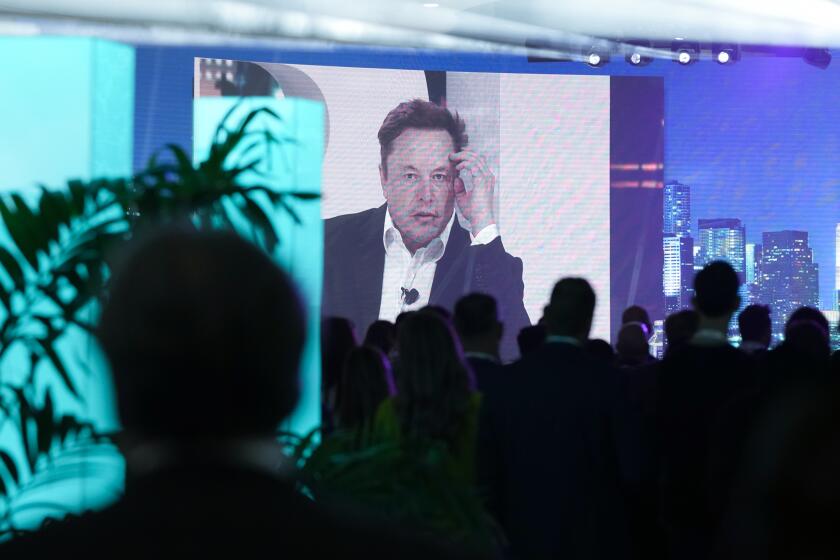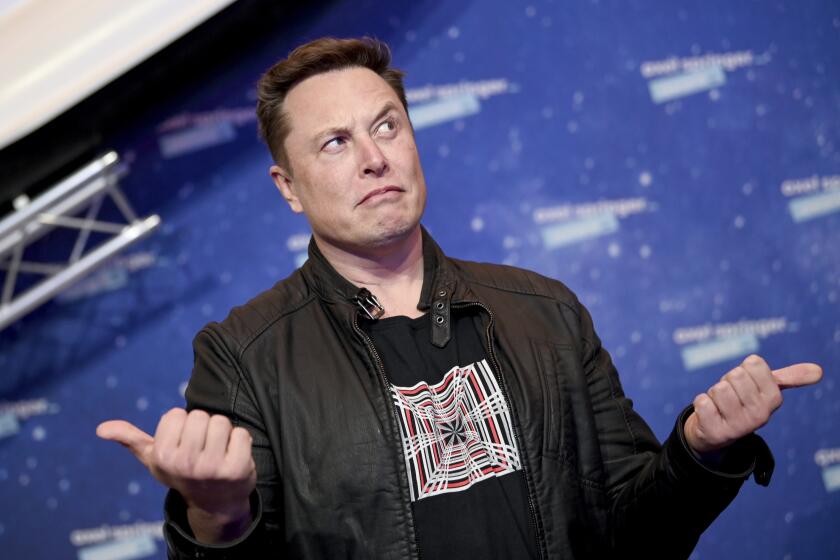Column: Elon Musk’s dumbest idea is to send human colonists to Mars

- Share via
The image of Elon Musk that may be dominating people’s mindspace at the moment is of his prancing about joyously — and, yes, a tad weirdly — behind Donald Trump on the podium during the latter’s Oct. 5 rally in Butler, Pa.
But how many people noticed the clue to Musk’s worldview on display at the event? For visible under his jacket was a T-shirt bearing the legend, “Occupy Mars.”
That’s a pointer to one of Musk’s most dearly held goals, which is to populate Mars with humans, transported to the Red Planet presumably by Musk’s rocketship company SpaceX. Musk has been airing this idea for years, even a decade or more. His mantra, as he tweeted as recently as a few weeks ago, is that “becoming multiplanetary is critical to ensuring the long-term survival of humanity and all life as we know it.”
Outer space seems designed to kill us.
— Scientific American
Musk brings up the idea of colonizing Mars so often that it can properly be regarded as a whim of iron. It’s a whim because he plainly hasn’t pondered soberly the obstacles in the way.
The technical challenges of sending a spacecraft to Mars, the distance to which from Earth averages about 140 million miles, are plainly the least difficult, since we’ve already done it: NASA landed the robotic rovers Spirit and Opportunity on Mars in January 2004.
Get the latest from Michael Hiltzik
Commentary on economics and more from a Pulitzer Prize winner.
You may occasionally receive promotional content from the Los Angeles Times.
Spirit functioned for five years, sending telemetry back to Earth from its five-mile range; Opportunity ranged over 28 miles of the Martian landscape for an amazing 15 years (its fascinating and endearing life story is told by “Good Night Oppy,” a documentary streaming on Amazon Prime).
All the other challenges are harder, and many are not amenable to human ingenuity at this stage. They’re financial, biological and psychological — and also technical, when the question is not how to get to Mars but how humans can function and survive once we’re there, much less establish a permanent presence.
Musk’s timeline for colonizing Mars has shifted constantly since he began bringing it up. Last month he announced that the first Mars-bound Starships would launch (unmanned) in two years, when Mars and Earth come to their nearest approach, as they do every 26 months or so.
If the landings succeed, the first crewed missions would take place two years later. Further flights, he said, would fulfill the goal of building a “self-sustaining city in about 20 years.”
Space exploration aficionados experienced the thrill of anticipation in the hours before President Trump’s speech Tuesday night, with advance word that he was going to call for a return to the human exploration of space.
Yet he also has talked about sending 1 million human colonists for that self-sustaining city in Mars by 2050, a mere 24 years after the first manned touchdown. In 2020 he posited building a fleet of 100 Starships every year for 10 years, parking them and their passengers in Earth orbit to await the next Earth-Mars near approach.
Such pronouncements have often elicited credulous reactions from Musk’s interviewers. They should know by now, however, that taking them at face value is the wrong way to bet.
Musk is notorious for the unreliability of his timing and engineering forecasts. While his words are taken as gospel by his fan base, many in the automotive and high-tech communities have learned from bitter experience not to trust them. It’s proper to ask whether he has ever met a self-imposed deadline for bringing out a new product or feature or fulfilled his claims for their capabilities.
The freshest example was his Oct. 10 unveiling of prototypical self-driving taxis and vans amid claims that his EV company Tesla would have fully autonomous vehicles on the road next year. Tesla shares fell nearly 9% the next day, thanks to world-weary investors who had heard such overcooked claims from him before. (A prototype humanoid robot introduced at the same event and implied to operate autonomously was later revealed to be human-assisted.)
If Musk can’t meet deadlines a few years off, then, why would anyone buy projections dated a quarter-century into the future?
Fancies about interplanetary travel may have their sedulous followers, but skepticism about Musk’s Martian fantasy have been mounting. Last month, the Wall Street Journal did the math on the 26-month cycle in which the Earth and Mars approach each other close enough to make travel between them practical, and reported that Musk’s timeline for Mars settlement was unlikely within his lifetime. (He’s 53.)
As for the other obstacles, they’re legion. One is the question of who would pay for the project. As rich as he is — he is often described as the richest or second-richest person on Earth, with a fortune estimated at $195 billion — he doesn’t have the resources to go it alone.
Elon Musk says he’s relocating his companies to Texas because California laws ‘attack ... families.’ Wait till he learns about Texas laws restricting parents’ rights over their own children.
Indeed, without its billions of dollars in U.S. government contracts, SpaceX would be going nowhere fast, even in Earth orbit. But whether the U.S. would have the political will or fiscal capacity to mount a project estimated to cost $1 quadrillion (that’s 1,000 trillions) is doubtful in the extreme even if spread out over several decades.
Space aficionados often compare the drive to explore other worlds to the impulse that sent humans on voyages around the world, depicting our forebears’ curiosity about our own planet as an innate curiosity that defines us as an alpha species. It’s comforting to think of ourselves that way, but more than a little pompous.
The truth is that the chief impulse that sent Europeans around the world was commercial. The Spanish came to the New World in search of gold, Russians for pelts, others for spices, raw materials, fishing grounds, etc., etc. They spent fortunes in these efforts, but they were willing to invest on the expectation of a healthy financial return.
Human interplanetary exploration will be more dangerous and more costly, especially if robots can do the work, and the lack of a discernible economic return a greater obstacle. “We haven’t even colonized the Sahara Desert, the bottom of the oceans or the moon, because it makes no economic sense,” the physician Danielle Teller observed nearly a decade ago. “It would be far, far easier and cheaper to ‘terraform’ the deserts on our own planet than to terraform Mars. Yet we can’t afford it.”
Will self-driving cars and artificial intelligence take over the world? A distinguished technology expert says don’t hold your breath.
NASA estimates the length of a voyage to Mars as at least nine months, during which the passengers would be bombarded by radiation and their bodies warped by weightlessness and by Martian gravity, which is 38% that of Earth. It may not be a survivable journey.
“Outer space seems designed to kill us,” Scientific American observed last year. “Humans evolved for and adapted to conditions on Earth. Move us off our planet, and we start to fail — physically and psychologically. The cancer risk from cosmic rays and the problems that human bodies experience in microgravity could be deal-breakers.”
Astronauts on the International Space Station, where the stays have typically been six months or less (a few record breakers have approached or exceeded one year), were known to have experienced weightlessness-associated visual impairments due to changes in the eye that were “not fully reversible upon return to Earth,” according to a 2018 study.
What would the colonists find upon arrival?
They would encounter a barren landscape without water or breathable atmosphere, bathed in deadly solar and galactic radiation from which Earthbound humans are protected by our planet’s atmosphere and magnetic field. Food, water and other resources would have to be shipped from home, at distances that make the supply frighteningly undependable. They would have to live underground, adding to psychological disorientation compounded by their sheer remoteness; they would be the first humans who were living beyond a view of Earth itself.
Elon Musk has gone full antisemite, raising questions about the future of his companies and their relationships with commercial and government entities.
Mars is more inhospitable to human occupation than the most punishing terrestrial environments, such as Antarctica and the remote desert. Its average surface temperature is minus 85 degrees, and can fall as low as minus 225 degrees.
Then there are the psychological pressures of underground life hopelessly far from home. An oft-mentioned cautionary tale is the experience of Biosphere 2, in which eight volunteers — four men and four women — were sealed in a futuristic glass structure in Arizona from 1991 to 1993 as an experiment in remote self-sustained living.
They raised crops and domestic animals for food and enjoyed their lifestyle, until “the human element” intervened, as one of the subjects wrote later. “We contracted a syndrome psychologists call irrational antagonism. That is, we split into two groups of four. A power struggle over the project’s direction made things much worse.” Their oxygen supply dwindled, producing a syndrome resembling altitude sickness, due to a miscalculation about photosynthesis.
They had encountered an age-old phenomenon common in insular communities cut off from home. The leader of the 19th century California utopian community Kaweah put it into words: His people “divided into factions, and fractions of factions,” he wrote. “Otherwise good people seem to take a delight in finding flaws in their neighbors.”
It may be that technological advances will eventually overcome these obstacles. But it’s also true that human ingenuity already has produced a solution to some of the most pressing: robots. For what Spirit and Opportunity proved is that there’s little of value that humans can do in deep space that robots can’t do as well, or better.
The ultimate question about Musk’s project is why? His vision seems to have been formed at the age when adolescents become enthralled by science fiction movies set in faraway galaxies — which isn’t to say that they can remain entertaining for adults, too.
But for him, reality is a distraction. For less than the stupendous cost of colonizing Mars, humanity could address the issues that Musk feels will make the Earth uninhabitable, such as global warming. Leaving an Earth warmer by 2 degrees centigrade for Mars “would be like leaving a messy room so you can live in a toxic waste dump,” Kelly and Zach Weinersmith wrote in their 2023 book, “A City on Mars: Can We Settle Space, Should We Settle Space, and Have We Really Thought This Through?”
Good question. Musk plainly hasn’t thought it through, at least not enough to avoid dismissing the challenges with hand-waving. But we can. Our imperative is to fix the home we live in before setting forth to ruin another one.
More to Read
Get the latest from Michael Hiltzik
Commentary on economics and more from a Pulitzer Prize winner.
You may occasionally receive promotional content from the Los Angeles Times.













